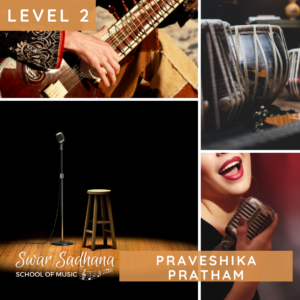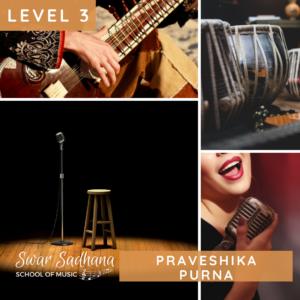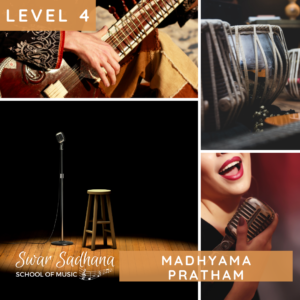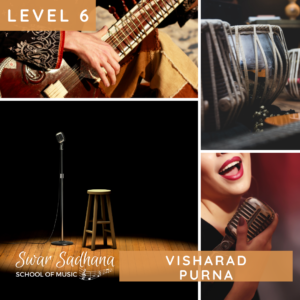Course Structure
We offer 6 levels of courses.

Overview
This course is ideal for students looking to make their basic foundation for learning Hindustani classical vocal Music. After completing this course the student will have ability to sing basic notes with clarity and stability, merging their voice with tanpura The student will be able to make small musical alaps with improvisation, Sing with taal (beats).
Along with classical music this course also focuses on learning some light music songs e.g. bhajan, sufi, motivational songs, filmy music.
Knowledge of swaraas and Raagas
- Singing and playing of the basic seven suddha swaraas (pure notes) and komal ,tivra swaras in simple groups. Basic knowledge of alankaras (Ascending and descending pattern of notes)
- Learning ten different thaats
- One song in each of the following eight Raagas and one Lakshangeet (a song that defines the basic characteristics of a raagas) in any two of them
Bhoopali, Durga, Khamaj, Kalyan, Bhimpalas, Kafi, Des, Bageshree
Knowledge of Taalas
Learning basics of taal(beat) Teentaal, Jhaptaal. Ability to demonstrate the taalas by means of taali (clapping with both hands).
Theory: Basic definition of Aaroha, Avaroh, Vaadi swar, Samvadi swar, Samaya, Jaati
Theory: Basic definition of Aaroha, Avaroh, Vaadi swar, Samvadi swar, Samaya, Jaati[/vc_column_text][/vc_tta_section][vc_tta_section i_icon_fontawesome=”fas fa-book-open” add_icon=”true” title=”Course 2 – Level 2 (Praveshika – Pratham)” tab_id=”1640174029504-a5d43d10-ae60″][vc_column_text]
Overview
In this Course students develop ability to sing Raagas with Alaaps, Boltaans and Taanas in different speeds from Vilambit to Drut. They also develop vision to make their own alaaps and singing in avartan. Students are also taught semi classical songs based on different Raagas.
Knowledge of swaraas and Raagas
- Ability to sing, play and understand the seven basic notes(swaraas) in the octave(saptak).
- Ability to sing and play sinple alankaras in slow(vilambit), medium (Madhya) tempo.
- Ability to sing 5 minutes any four raagas from prambhik curriculum with Alaaps, Boltaanaas and Taanas.
- Ability to recognize these raagas from their Alaaps.
- Knowledge of Aaroha, Avaroh, Sthayi, Antara of the remaining four raagas.
Knowledge of Taalas
Ability to demonstrate Teentaal, Jhaptaal, Daadra, Kehrwa by means of taali (clapping with both hands)
Theory: Basic definition of Sum, Khaali, Maatra, Khand, Naad, Saptak, Mukhyaand, Taana, Lakshan geet, Dhwani, Palata, Sthayi, Antara, Laya, Vilambit, Madhya, Drut, Theka, Avartan, Varjit swar[/vc_column_text][/vc_tta_section][vc_tta_section i_icon_fontawesome=”fas fa-book-open” add_icon=”true” title=”Course 3 – Level 3 (Praveshika – Purna)” tab_id=”1640174106484-74a073f9-ebb4″][vc_column_text]
Overview
After completing this course the student develops ability to sing or play a khayaal composition with Alaap-Taanaas and Bol-Taanaas upto eight minutes in medium Tempo for any five Raagas listed below. They also develop ability to sing Bhajan ,Natyageet,Folk song based on these raagas.
Knowledge of swaraas and Raagas
- Expertise in singing, playing and recognizing the basic notes. Sufficient knowledge of vikrut swaraas (changes or perverted notes).
- In addition to repeating the Raagas from Praveshika –Pratham following ten raags to be learned during this course.
- Bihag
- Kedar
- Sarang
- Dhani
- Pilu
- Bhairav
- Tilang
- Tilak kamod
- Patdeep
- Alhaiya Blawal
- Ability to recognize these raagas from their alaaps
Knowledge of Taalas
- Ability to demonstrate all Taalas learnt so far by means of Taali in addition to Ektaal in Fast Tempo and Roopak taala.
Theory: Basic knowledge of Ansh, Nyas, Vikrut swar, Durbal Swar, Loma, Anuloma, Viloma, Pratiloma, Anuwadi, Vivadi, Alaap, Tana, Boltaans, Sthaayi, Arohi, Avarohi, Sanchari, Ganakriya or varna, Dvani, Nada, Shruti, Janak, Janya, Elements of a song (Sthayi, Antara, Sanchari, Abhog), Meend, Gamak
- Understanding of the Jaati and raga
- Rules of a Raga ‘s construction or make-up
- Complete understanding of 18 raagas covered so far
- Study of two systems or methods for writing Music namely the Pandit Vishnu Digambar Paluskar method and Pandit Bhatkhande method.
- Students are expected to write all the Taalas and some raagas in one of these method
[/vc_column_text][/vc_tta_section][vc_tta_section i_icon_fontawesome=”fas fa-book-open” add_icon=”true” title=”Course 4 – Level 4 (Madhyama – Pratham)” tab_id=”1640174146276-ccbfe057-1195″][vc_column_text]
Overview
After completing this course the student develops ability to sing Bada khyal and Chota khyal in vilambit, madhyalaya and drup speed along with alaaps, boltaans and taans. Students also develop ability to sing semi classical based songs bhajans, natyasangeet and many other forms.
Knowledge of swaraas and Raagas
- Singing and identifying shuddha and vikrut swar
- Ability to sing vilambit and drut khyal with self improvisation
- Ability to sing Bada khyal for atleast 12 minutes along with alaap, boltaan and taans
in following .
Raags covered: Kalyan, Bageshree, Bhairav , Bihaag
- Ability to sing chota khyal madhyalaya bandish for atleast 10 minutes along with alaap, boltaans and taans
Raags covered: Hameer, Asawari, Shankara, Makauns, Mand, Deshkar
Knowledge of Taalas
Ability to demonstrate on hands all the taals learned before along with Chautaal and Ektaal .
Speaking all the bols and show dugun.
Theory
- Learning comparison between learned raagas
- Writing all the taals in single and dugun.
- Knowledge of dhrupad, dhamar, vilambit khyal, chota khyal, bhajan and geet
- Knowledge pf lokageet, Bhaavgeet and chitrapat sangeet
- Writing Drut composition
- Introduction to north and south hinduatani classical music
- Naad, Murki, Jaati, Ghasit, jamjama definations
- Learning life history of Pandit Vishnu Narayan Bhatkhande and Pandit Vishnu Digambar Paluskar.
- Study of swarleepi
- Writing Drupad in Dugun laya
[/vc_column_text][/vc_tta_section][vc_tta_section i_icon_fontawesome=”fas fa-book-open” add_icon=”true” title=”Course 5 – Level 5 (Madhyama – Purna)” tab_id=”1640174181102-455146b6-4c85″][vc_column_text]
Overview
After completing this course the student develops ability to sing Bada khyal and Chota khyal in vilambit, madhyalaya and drup speed along with alaaps, boltaans and taans. Students also develop ability to sing semi classical based songs bhajans, natyasangeet and many other forms.
Knowledge of swaraas and Raagas
- Ability to sing, play and identify Shuddha and Vikrut swar. Learning to tune tanpura. Using different types of alankar
- Reading and Writing Swar leepi
- Singing Vilambit and drut bandish with swar vastaar for approximately 15 minutes in two out of this five ragas.
Chhayanut, Puriyadhanashree, Bhimpalasi, Jaijaiwanti, Asawari
- Ability to sing madhyala bandish for atleast 10 minutes in following raagas
Kamod, Kalingada, Bhairavi, Hindol, Bahar
- Ability to sing Drupad, Dhamar,(with dugun and chaugun),two tarana’s, Drut ektaal bandish
- Ability to sing Natyasanheet,bhajan,bhajan based on Raaga
Knowledge of Taalas
Ability to demonstrate on hands all the taals learned before along with Teevra and Sultaal. .
Speaking all the bols, writing the taal and showing on hands required.
Theory
- Knowledge about difference in all the learned raagas along with alaap and taans
- Knowledge of taal khand, bol, sum, kaal. Ability to write them.
- Knowledge about drupad, dhamaar and khyaal
- Defination of Purvand, Uttarang, Purva raag, Uttarraag, Varna, Khatka, Murki, Gamak, Aandolan
- Writing notation of bada and chota khayal
- Learning life history of Pandit Balkrishna Buva Ichalkaranjikar and Ustad Abdul Kareem Khan
- Knowledge of shuddha, chayalagatva, Mishra, sankirna, raag jaati definition
- Learning different types of taans
- Knowledge about dhwani

Overview
This course is ideal for students looking to make their basic foundation for learning Hindustani classical vocal Music. After completing this course the student will have ability to sing basic notes with clarity and stability, merging their voice with tanpura The student will be able to make small musical alaps with improvisation, Sing with taal(beats). Along with classical music this course also focuses on learning some light music songs. Ex bhajan, sufi ,motivational songs, filmy music.
Knowledge of swaraas
- Singing and playing of the basic seven suddha swaraas (pure notes) and komal, tivra swaras in simple groups. Basic knowledge of alankaras (Ascending and descending pattern of notes).
- Learning ten different thaats
- One song in each of the following eight Raagas and one Lakshangeet (a song that defines the basic characteristics of a raagas) in any two of them
Knowledge of Taalas
Learning basics of taal(beat) Teentaal, Jhaptaal. Ability to demonstrate the taalas by means of taali (clapping with both hands)
Theory: Basic definition of Aaroha, Avaroh, Vaadi swar, Samvadi swar, Samaya, Jaati
